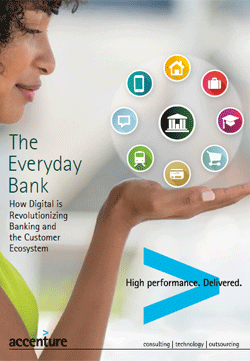
The Everyday Bank
Die Digitalisierung revolutioniert das Banking und die Beziehung zum Kunden. Banken, die sich darauf einstellen, können höhere Erträge erwarten. Dazu müssen Banken zum unverzichtbaren Alltag der Menschen gehören.
As the digital revolution drives changes in consumer behaviors and expectations, banks must become the indispensable, Everyday Bank-positioned to fulfill all their customers‘ daily financial and non-financial needs.
As technology drives dramatic changes in consumer behavior and expectations, so it drives changes in financial transactions. Relatively new players such as PayPal have entered the transactions market, while entities like Amazon have changed the game around anticipating customers‘ needs. Thanks to these shifting sands, 20 percent of customers changed some or all of their retail banking products in 2012. For banks, up to a third of their revenues could be at risk.
https://://www.youtube.com/watch?v=tGcfUgHtI5I
An Everyday Bank offers a complete customer solution. Using digital levers, this bank evolves the entire business model, opening access to new business sources, new customers and new profit pools. This bank convenes a digital ecosystem, assembling existing provider partners and other key players, creating digital connections and establishing equitable value sharing. The bank reinvents itself as a value aggregator, provider and access facilitator. In short, the Everyday Bank places itself at the vital center of a digital village of its own design, one driven by the bank’s digital engine.
With this increased role in the buying chain, the Everyday Bank opens more opportunities for revenue, from customers and third party vendors.
Behind the curtain, the Everyday Bank is highly industrialized, with automated front- and back-office processes that are integrated and optimized for speed, efficiency and scalability. A high-functioning Everyday Bank can slash back office effort up to 80 percent. It can reduce its managed applications portfolio by 70 percent. Even better, the Everyday Bank may cut its time to market by 40 to 50 percent while increasing its operating income by up to 35 percent.
Thanks to the rich data they possess about their customers’ purchasing and spending habits, banks occupy the perfect space to construct a digital village: They can ensure ecosystem partners—merchants, service providers and other retailers—get point-of-purchase access to buyers. At the same time, they anticipate customers’ needs and point them to ideal providers. Add in economies of scale and banks are able to offer better pricing and higher value to both customers and merchants.
The Everyday Bank’s customers gain efficiency from this digital world. They enjoy an improved experience that meets their increased expectations while saving time and money. The Everyday Bank provides advice, offers point-of-need access to goods and services and, by building economies of scale, acts as a value aggregator, delivering lower costs to consumers. The Everyday Bank brings with it pricing transparency, trusted advice, social recommendations and transactions–as easy as one click.
Quelle: Accenture
Die Studie „The Everyday Bank – The Digital Way Forward for Banking“ kann hier direkt heruntergeladen werden.


